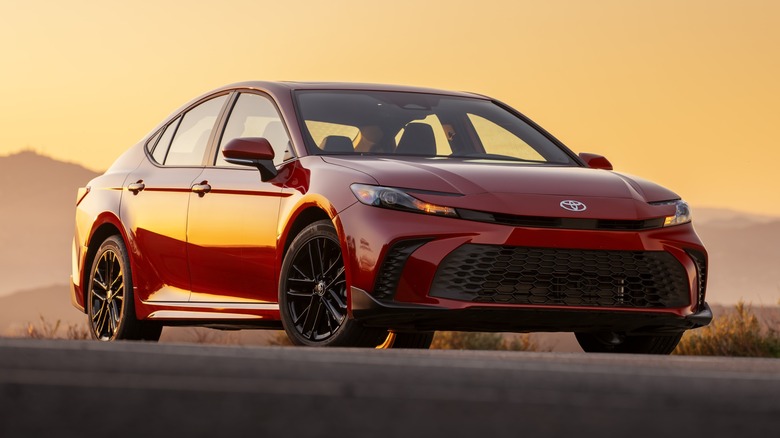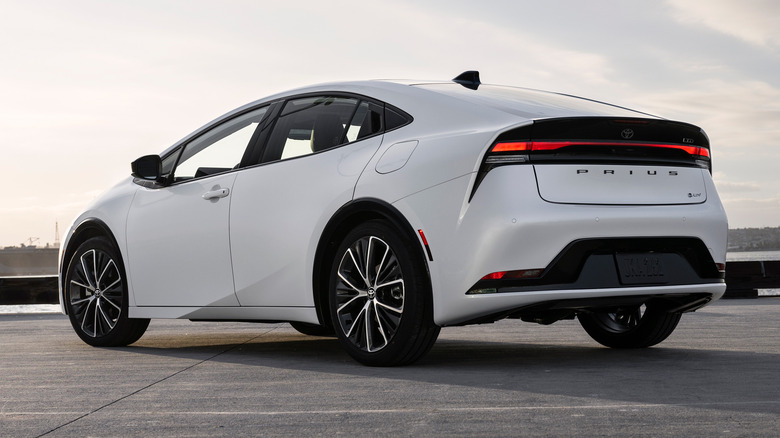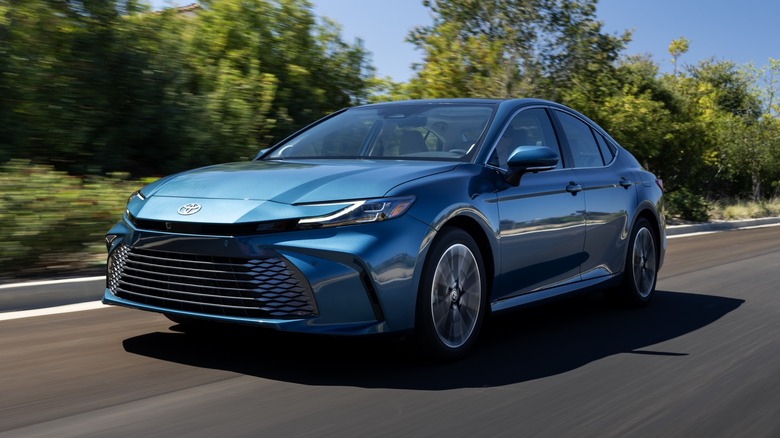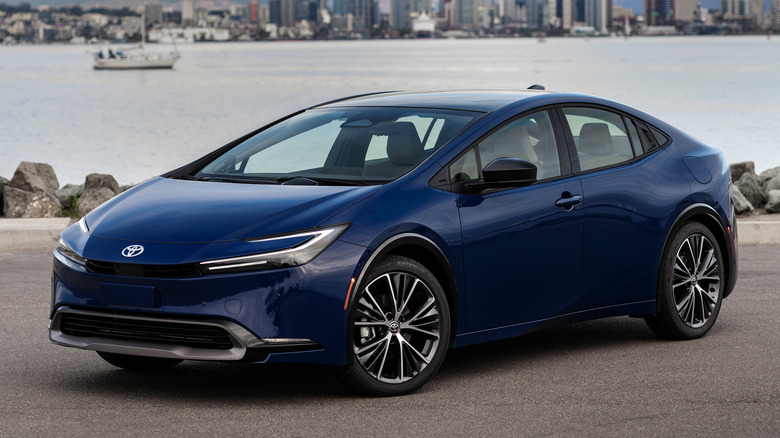Why Your Next Toyota Hybrid Should Be A Camry, Not A Prius
For a long time, the Toyota Prius was the first car that came to mind when someone said the word "hybrid". It was the best game in town when it came to economical personal transportation. It provided nearly-unmatched fuel economy, no need to plug in, and a big dose of hatchback practicality, all at a low price. The newest Toyota Prius is certainly a head-turner, which certainly boosts its appeal, but the Prius has always been about one thing above all others: fuel economy.
It's not the only car with high fuel-economy standards, though. Standard hybrids, plug-in hybrids, and full-EV's are expanding across the automotive world and competition is stiff. There are a number of strong rivals for the Prius, including hatchbacks, sedans, and several small hybrid SUVs. Some of the most aggressive competition for the Prius, however, comes from inside its own family tree.
Instead of a confusing, multi-powertrain, multi-trim-level options sheet, the 2025 Toyota Camry now has just a few simple trim levels. All of them are hybrid-powered and all of them are available with all-wheel drive. What's more, the Camry is more entertaining to drive than before. So instead of making the quick jump to opt for a Prius as your next vehicle, you might want to check out the Camry first. After all, it is one of Toyota's longest-lasting and most reliable vehicles.
Where the Prius shines
The Toyota Prius is more efficient than the Camry — it wins that battle outright. Depending on which trim you go with, and whether you need all-wheel drive, the Prius is rated by the EPA to achieve as much as 57 mpg combined. The lowest fuel economy rating the Prius gets from the EPA is a still-respectable 49 mpg combined. While the EPA hasn't rated the 2025 Camry yet, Toyota's manufacturer estimates have it topping out at 51 mpg combined, with its lowest rating checking in at 44 mpg combined. Those numbers are good for the class, and about even with something like the Honda Accord Hybrid, but they can't quite match the plucky Prius.
As a hatchback, the Prius wins outright in the cargo category, too. It has 20.3 cubic feet of cargo space behind the rear seats, while the Camry only has 15.1 cubes. The Prius also has a few features that the Camry doesn't. The Camry doesn't get heated rear seats, on any trim level. On top Limited trim levels, heated rear seats are optional for the Prius — a nice touch if you're carting around ride-share passengers in the back seat. The Prius is also less expensive, at least on the lower trim levels. The base Prius LE checks in at $27,950 (plus destination) while the base Camry LE is slightly higher at $28,400.
Why upgrading to a Camry makes sense
While the Camry is a bit less efficient, has slightly less cargo room, and is slightly more expensive on the base trim levels, it has a lot going for it as a driver's car. The Prius is powered by a 2.0-liter four-cylinder engine paired with the hybrid system, putting out a combined total of 194 horsepower (196 hp with AWD). The Camry's 2.5-liter engine pushes power up to 225 hp on front-wheel drive models and 232 hp on all-wheel drive models. As a result, the Camry feels a bit more lively and engaging. The Camry also has a slightly longer wheelbase than the Prius (111.2 inches for the Camry, 108.3 inches for the Prius) and the resulting ride quality is better in the Camry.
In the back seat of the Camry, your passengers will likely be more comfortable thanks to a big difference in rear legroom. The Prius has 34.8 inches of rear legroom, while the Camry has 38 inches. Front headroom and legroom measurements for the Prius and Camry are pretty close (the Prius has slightly more of both) but the Camry has a big edge when it comes to rear headroom and shoulder room. Seating three passengers in the back of a Camry is much less of a squeeze. Also, in the higher trim packages, the Camry prices fall below Prius prices, with a Prius Limited AWD coming in at $36,365 (plus destination) while the Camry XSE AWD is $36,125.
What they both get
More rear passenger space, a better ride quality, and a more engaging driving feel make the Camry a winner when it comes to the ownership experience. Plus, it has a few features that the Prius doesn't offer, like an available head-up display and an available power-sliding panoramic glass roof (the Prius only offers a fixed sunroof). The Camry comes standard with wireless smartphone charging, but on the Prius, it's optional. Those are just a few additional reasons why the Camry should be your next choice. But, these two hybrids have a lot of overlap in terms of standard features, so buyers who prefer the Prius' ultra-efficient numbers won't be hurting for creature comforts.
Both the Prius and the Camry come with a standard 8-inch infotainment screen and the option to upgrade to a 12.3-inch touchscreen. They both come standard with wireless Apple CarPlay and Android Auto compatibility. The warranty coverage on these two Toyota's is also identical. Both get a three-year/36,000 mile comprehensive warranty, five years/60,000 miles for their powertrains, 10 years/150,000 miles for the hybrid battery, and two years of ToyotaCare coverage which covers all factory scheduled service for the first two years/25,000 miles and 24/7 roadside assistance.



